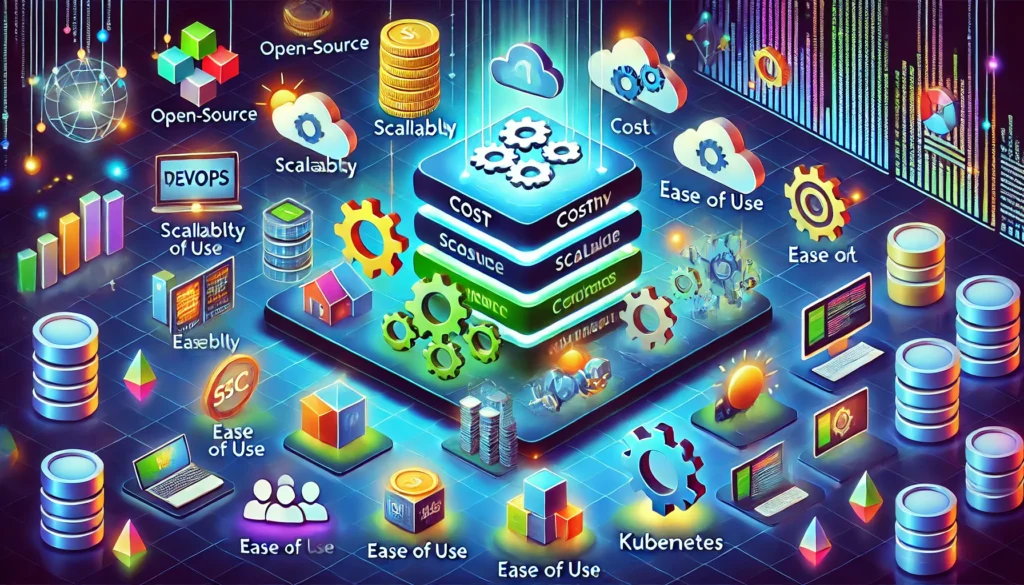Cost-effective DevOps tools for startups

The right DevOps tools at the appropriate moment can be a game-changer. For startups with limited resources, these tools are not just a luxury but a necessity. They automate and streamline essential processes, enabling teams to focus on innovation and growth rather than getting bogged down in manual tasks. Whether it's automating code integration, enhancing collaboration, or ensuring scalable infrastructure, DevOps tools play a critical role in building a robust, efficient, and resilient IT operation.
This article aims to guide startups in identifying and evaluating cost-effective DevOps tools that can help streamline their IT operations without stretching their budgets. By focusing on tools that offer high ROI, flexibility, and scalability, we'll explore how startups can effectively implement DevOps practices to boost efficiency and stay competitive in a fast-paced market.
Cost-effective DevOps tools for startups — you are here
Introduction to DevOps tools
Overview of DevOps tools
DevOps tools are the backbone of modern software development, playing a pivotal role in automating and streamlining the entire development lifecycle. These tools can be grouped into several key categories based on their functionalities:
- Continuous Integration/Continuous Deployment (CI/CD): Tools like Jenkins and CircleCI are essential for automating the build, test, and deployment processes. They ensure that code changes are seamlessly integrated into the project and deployed to production environments with minimal friction, reducing the time it takes to deliver new features and updates.
- Automation: Tools such as Ansible and Terraform are crucial for automating infrastructure provisioning and management. By reducing manual efforts, these tools minimize the risk of human error and enable faster, more reliable deployments. Automation is key for startups looking to maintain efficiency and consistency as they scale.
- Monitoring: Monitoring tools like Prometheus and Grafana continuously track the performance and health of applications, providing real-time insights that are vital for maintaining stability and reliability. These tools help teams identify and resolve issues before they impact the user experience, which is especially important for startups striving to build a strong reputation for reliability.
Selecting the right DevOps tools is particularly critical for startups. The tools you choose can significantly influence your team's productivity, the quality of your product, and your ability to respond quickly to market demands. The right set of tools will not only automate repetitive tasks but also enhance collaboration and ensure that your applications run smoothly in production environments.
Criteria for selecting DevOps tools

When choosing DevOps tools, startups must consider several factors to ensure they are making the most effective and sustainable choices:
- Cost. Startups typically operate on tight budgets, so opting for open-source tools like Jenkins or GitLab CI/CD, which offer robust features without the need for expensive licenses, can be a game-changer. These tools allow startups to implement best-in-class practices without significant financial investment.
- Scalability. As your startup grows, so will your infrastructure and workload demands. Tools like Kubernetes and Docker are designed to scale alongside your business, ensuring that your DevOps processes can handle increased complexity and volume seamlessly.
- Ease of use. For teams that may not have deep DevOps expertise, tools that are straightforward to set up and manage, such as Ansible, are invaluable. These tools can help teams implement and manage complex operations with relative ease, reducing the learning curve and accelerating adoption.
- Community support. A strong community around a tool means access to a wealth of resources, including plugins, updates, and troubleshooting advice. Tools like Jenkins and Docker benefit from large, active communities, which can be a critical asset for startups that need quick solutions and ongoing improvements.
- Integration capabilities. The ability of a tool to integrate seamlessly with other tools and platforms is crucial for building a cohesive DevOps pipeline. For example, Jenkins integrates well with other popular tools like GitHub, Docker, and Kubernetes, making it an excellent choice for startups looking to create a comprehensive and flexible DevOps environment.
By carefully considering these criteria, startups can select the right DevOps tools to optimize their IT operations, enhance productivity, and position themselves for sustainable growth.
Free and open-source DevOps tools
Popular free tools
- Jenkins for CI/CD. Jenkins stands out as one of the most popular open-source automation servers, particularly valued for its role in continuous integration and continuous delivery (CI/CD). It supports an extensive ecosystem of plugins, allowing developers to tailor the tool to fit various development workflows. Jenkins automates the building, testing, and deployment of applications, streamlining the entire software delivery process. A typical use case involves integrating Jenkins with Docker and Kubernetes, which enables the automation of deploying containerized applications. This integration is vital for startups looking to maintain a fast, efficient, and reliable CI/CD pipeline without incurring significant costs.
- Docker for containerization. Docker is a platform that revolutionized the way developers package and deploy applications. By encapsulating applications and their dependencies into containers, Docker ensures that they run consistently across different environments. This containerization approach is particularly advantageous for startups, as it helps create isolated environments that mirror production conditions. This consistency is crucial in mitigating deployment issues that typically arise due to discrepancies between development and production environments. Docker’s lightweight nature also means it uses fewer resources than traditional virtual machines, making it a cost-effective solution for startups.
- Kubernetes for orchestration. Kubernetes is an open-source platform designed to automate the deployment, scaling, and management of containerized applications. It is indispensable for managing large-scale, complex systems, particularly as startups grow and their infrastructure needs become more demanding. Kubernetes ensures that applications are resilient, with self-healing capabilities that automatically recover from failures. Its seamless scaling features allow startups to handle increased workloads without significant downtime or performance degradation, making it a critical tool for maintaining reliability in production environments.
Community and support
- Importance of community support. One of the greatest strengths of open-source DevOps tools like Jenkins, Docker, and Kubernetes is the robust community support that surrounds them. These tools have large, active communities that contribute to their ongoing improvement and evolution. This collective knowledge base is invaluable for startups, providing access to a wealth of resources for troubleshooting, discovering best practices, and staying updated on the latest developments in the DevOps world. The active participation of the community ensures that these tools remain cutting-edge and capable of meeting the ever-changing demands of software development.
- Leveraging community resources. To fully capitalize on the benefits of community support, developers and teams can actively engage in forums, participate in discussions, and utilize the extensive tutorials and documentation available online. Many communities host webinars, contribute to open-source plugins, and maintain detailed documentation, all of which are crucial for solving problems and optimizing workflows. By tapping into these resources, startups can enhance their DevOps practices, overcome challenges more efficiently, and stay at the forefront of technology.
These free and open-source tools, supported by vibrant communities, provide startups with the flexibility and power needed to automate and streamline their development pipelines effectively, all while keeping costs low.
Cost-effective paid DevOps tools with high ROI
Overview of affordable paid tools

In the dynamic world of software development, startups need tools that offer significant value without overwhelming their budgets. Paid DevOps tools can provide advanced features and support that elevate operational efficiency, streamline collaboration, and enhance productivity. Here, we’ll highlight some cost-effective paid tools that deliver high returns on investment (ROI) for startups.
Detailed reviews of key tools
GitLab CI/CD
- Features. GitLab CI/CD offers an integrated CI/CD pipeline that automates the entire software development lifecycle, from code integration to deployment. It comes with built-in version control and project management features, making it a comprehensive solution for managing development processes. GitLab supports a variety of programming languages and frameworks, and its extensive documentation ensures that teams can maximize its potential.
- Pricing. GitLab offers a free tier with basic features, suitable for small teams or early-stage startups. For more advanced features, such as security scanning and performance monitoring, paid plans start at $19 per user per month. This pricing structure allows startups to scale their usage as they grow.
- Startup use cases. Startups can leverage GitLab CI/CD to automate testing and deployment, which reduces the time-to-market for new features. Its integrated nature allows teams to manage both code and CI/CD processes within a single platform, enhancing collaboration and operational efficiency.
CircleCI
- Advantages for startups. CircleCI is a flexible and powerful CI/CD platform that supports multiple environments, including Linux, Windows, and macOS. It offers custom job orchestration, enabling teams to define workflows that meet their specific needs. This flexibility makes it ideal for startups with diverse development environments or specialized requirements.
- Pricing model. CircleCI provides a free tier with limited build minutes, making it accessible for small teams. Paid plans start at $15 per month, offering additional build minutes and advanced features. This pricing allows startups to start small and expand as their CI/CD needs grow.
- Integration capabilities. CircleCI integrates seamlessly with popular version control systems like GitHub and Bitbucket, as well as other tools like Slack, Jira, and AWS. This broad integration capability makes it easy to incorporate CircleCI into existing workflows, enhancing overall productivity.
Balancing cost and benefits
When evaluating the ROI of paid DevOps tools, startups should consider several key factors:
- Cost of ownership. Beyond subscription fees, assess associated costs such as training, maintenance, and potential scaling expenses. For instance, a tool that requires minimal training and scales easily can reduce long-term costs.
- Time savings. Automation and streamlined workflows offered by these tools can significantly reduce development cycles, leading to quicker revenue generation. Faster deployments mean startups can respond to market changes and customer feedback more swiftly.
- Quality improvements. Tools like GitLab CI/CD and CircleCI improve code quality by automating testing and reducing bugs. This can lower support and maintenance costs while enhancing customer satisfaction.
- Scalability. It’s crucial to choose tools that can grow with your startup, accommodating increased workloads and user demands without requiring a complete overhaul. Both GitLab CI/CD and CircleCI are designed to scale, ensuring that as your startup expands, the tools continue to support your needs effectively.
- User adoption. Tools that are intuitive and integrate well with existing processes tend to see higher adoption rates, leading to better outcomes. The ease of use and integration capabilities of GitLab CI/CD and CircleCI make them popular choices among startups.
Case studies of startups benefiting from these tools
- Tech startup using GitLab CI/CD. A tech startup implemented GitLab CI/CD to streamline its development processes. By automating testing and deployment, they reduced their release cycle from weeks to days. This improvement significantly enhanced their ability to respond to customer feedback and market demands, giving them a competitive edge in their industry.
- E-commerce startup utilizing CircleCI. An e-commerce startup adopted CircleCI for its CI/CD needs. The flexibility of CircleCI allowed them to customize workflows, which improved collaboration between development and operations teams. As a result, they saw a 40% reduction in deployment errors, leading to a smoother user experience on their platform and better customer retention.
Integration and automation tools
Essential tools for integration

- Ansible for configuration management. Ansible is a powerful, user-friendly automation tool that excels in configuration management, application deployment, and orchestration. One of its key advantages is its agentless architecture, which simplifies the setup and management of various systems. Unlike other tools that require agents to be installed on each node, Ansible communicates directly with systems using SSH, reducing complexity and potential points of failure. Ansible uses YAML for its configuration files, making it accessible even to teams with limited coding experience. This simplicity, combined with its scalability, makes Ansible particularly well-suited for startups. It allows for quick deployments and automated management of IT infrastructures, enabling startups to focus on growth and innovation rather than manual configuration tasks.
- Terraform for infrastructure-as-code. Terraform, developed by HashiCorp, is a leading tool for managing infrastructure as code (IaC). It allows users to define and provision infrastructure using a declarative configuration language, ensuring that resources are consistently and predictably managed across multiple cloud providers. Terraform's approach simplifies the management of complex environments, making it easier to maintain infrastructure as your startup scales. One of the significant benefits of Terraform is its cost-effectiveness—it automates infrastructure provisioning, reducing the need for manual intervention and minimizing the risk of errors. This automation not only saves time but also lowers operational costs, making Terraform a valuable tool for startups looking to efficiently scale their operations.
Automation tools
Automating repetitive tasks to save time and resources
In a DevOps environment, automating repetitive tasks is essential for saving time, reducing errors, and improving overall efficiency. Tools like Ansible, Puppet, and Chef are designed to handle these tasks, such as configuring servers, deploying applications, and managing updates. By automating these processes, startups can ensure that their systems are consistently and correctly configured, freeing up valuable time and resources to focus on more strategic activities. Automation also helps maintain a stable and reliable infrastructure, which is critical as startups scale and their operational complexity increases.
Puppet and Chef: When and why to use them
- Puppet. Puppet is a well-established tool known for its scalability and strong ecosystem. It operates with a master-agent architecture, allowing centralized management of large, complex infrastructures. Puppet uses declarative language to enforce the desired state across many systems, making it particularly beneficial for enterprises with strict compliance and auditing requirements. Startups that anticipate rapid growth or have complex compliance needs might find Puppet's robust framework advantageous.
- Chef. Chef takes a procedural approach to infrastructure management, excelling in environments that require high customization and complex workflows. It uses Ruby as its configuration language, which offers significant flexibility for managing intricate dependencies and performing detailed configurations. Chef is ideal for organizations that need to manage highly customized environments, though it comes with a steeper learning curve and a more complex setup process compared to Ansible and Puppet. Startups with specific, complex requirements may find Chef to be the right tool, despite its initial complexity.
By leveraging these integration and automation tools, startups can significantly enhance their operational efficiency, reduce errors, and ensure consistent infrastructure management. Ansible and Terraform provide powerful, scalable solutions for configuration management and infrastructure provisioning, while Puppet and Chef offer tailored options for more complex or specialized environments. Each tool brings unique strengths to the table, helping startups automate their workflows and focus on scaling their business.
Implementing DevOps tools in startups
Implementing DevOps tools in startups is a pivotal move toward enhancing both software development efficiency and operational effectiveness. Here’s a comprehensive guide to facilitate this process, along with best practices and solutions to common challenges.
Step-by-step implementation guide
Initial setup and configuration
- Assess current infrastructure. Begin by thoroughly evaluating your existing IT infrastructure and workflows. Identify bottlenecks and areas where automation and integration could offer significant improvements. This foundational step ensures that the tools you select will address the most pressing needs.
- Select appropriate tools. Choose tools that align with your startup’s specific needs. Consider categories such as CI/CD (e.g., GitLab CI/CD, Jenkins), automation (e.g., Ansible, Terraform), containerization (e.g., Docker), and monitoring (e.g., Prometheus). Selecting the right tools from the start is crucial for effective implementation.
- Establish a DevOps environment. Set up the necessary environments for development, testing, and production. This might involve configuring cloud services, setting up version control systems like GitHub or GitLab, and establishing CI/CD pipelines to automate your software delivery processes.
Integrating tools into existing workflows
- Define integration points. Identify where and how the selected DevOps tools will integrate with your existing workflows. For instance, linking your CI/CD tools with your version control system ensures smooth code integration and deployment.
- Create a CI/CD pipeline. Implement a CI/CD pipeline that automates testing and deployment. This pipeline should include stages such as code integration, automated testing, and deployment to production, ensuring that each code change is reliably tested and deployed.
- Documentation. Maintain comprehensive documentation of all workflows, configurations, and processes. This ensures that your team can easily understand and follow the new processes, which is especially important as your team grows.
Best practices for tool integration
Ensuring seamless integration with minimal disruption

- Incremental implementation. Rather than introducing all tools at once, start with one or two and assess their impact on your operations. Gradually expand the toolset as the team becomes comfortable and the benefits are realized.
- Pilot programs. Run pilot programs with select teams to test new tools and processes. This approach allows for real-world feedback and necessary adjustments before a full-scale rollout, minimizing disruption.
Training and onboarding team members on new tools
- Comprehensive training programs. Conduct thorough training sessions to ensure that all team members are familiar with the new tools and processes. Hands-on workshops and access to resources like tutorials and documentation will help the team adapt more quickly.
- Encourage knowledge sharing. Promote a culture of knowledge sharing by encouraging team members to share their experiences and tips. This peer-to-peer learning can accelerate the adoption of new tools and practices across the team.
Common challenges and solutions
Addressing compatibility issues
- Evaluate tool compatibility. Before selecting tools, ensure they are compatible with your existing systems and workflows. During the pilot phase, conduct compatibility tests to identify and resolve potential issues.
- Use middleware solutions. If direct integration between tools is challenging, consider middleware solutions that can facilitate communication between different systems, ensuring smooth integration.
Overcoming resistance to change and ensuring adoption
- Communicate benefits clearly. Clearly articulate the benefits of the new DevOps tools and practices. Highlight how these changes will improve workflows, reduce manual effort, and ultimately make the team’s work easier and more efficient.
- Involve team members in the process. Engage team members in the selection and implementation of tools. Their input can foster a sense of ownership, making them more likely to embrace the changes.
- Provide ongoing support. Establish a robust support system for team members as they adapt to the new tools and processes. Offering continued assistance will help overcome any hurdles and ensure a smoother transition.
Maximizing the benefits of DevOps tools
To fully leverage the power of DevOps tools, both free and paid, it’s essential to continuously optimize their usage and remain committed to improvement. Here’s how you can maximize the benefits of your DevOps tools through regular optimization, gathering feedback, and staying updated with the latest features.
Optimizing tool usage
Regularly review tool configurations
- Assess tool usage. Periodically analyze how your team is utilizing each DevOps tool. Look for underutilized features or identify tools that are not fully integrated into your workflows. This assessment can uncover areas where improvements can be made, ensuring that every tool is being used to its fullest potential.
- Optimize configurations. Update tool configurations regularly to align with evolving business needs and industry best practices. This might involve adjusting user permissions, automating more tasks, or integrating additional tools to enhance functionality.
- Eliminate tool redundancy. Identify any overlap between tools that offer similar functionalities. By consolidating tools and eliminating redundancies, you can simplify your toolchain and reduce maintenance costs, making your operations more efficient.
Maximize free tool capabilities
- Leverage open-source tools. Utilize powerful open-source tools like Jenkins, Ansible, and Prometheus, which provide robust functionalities at no cost. Take advantage of their extensive plugin ecosystems and active community support to tailor these tools to your startup’s specific needs.
- Optimize free tool usage. Even when using paid tools, make the most of their free tiers or trial versions. Identify which features are critical for your operations and ensure they are fully configured to meet your needs before considering an upgrade to a paid plan.
- Explore freemium models. Some tools offer freemium models, providing basic functionality for free with the option to pay for more advanced features. Evaluate whether the free tier meets your current needs and upgrade only when necessary.
Get the most out of paid tools
- Assess ROI. When selecting paid tools, carefully evaluate the return on investment. Consider factors like the efficiency improvements, error reduction, and time savings that the tool provides. A tool that significantly enhances productivity can justify its cost.
- Leverage advanced features. Paid tools often come with advanced features such as enterprise-grade security, scalability options, and dedicated support. Ensure your team is aware of these capabilities and is using them to their full extent.
- Optimize licensing. Review your tool’s licensing models and adjust them as needed to avoid over-provisioning. Consider options like concurrent or floating licenses, which might offer more flexibility and cost savings.
- Provide training. Invest in training to ensure your team can effectively use all features of the paid tools. Comprehensive training maximizes the value of your investment and ensures that your team is equipped to utilize the tools efficiently.
Continuous improvement
Gathering feedback and making iterative improvements

- Establish feedback mechanisms. Regular check-ins, retrospectives, and surveys can help gather structured feedback from your team regarding their experiences with the tools. This feedback is crucial for identifying pain points and areas for enhancement.
- Analyze feedback. Organize feedback into categories such as usability, functionality, and integration. Look for common trends, as these likely indicate areas that need immediate attention.
- Implement iterative improvements. Prioritize changes based on the feedback analysis, focusing on those that will have the most significant impact. Test significant changes in a controlled environment before a full-scale rollout to ensure they deliver the desired benefits.
- Encourage a culture of continuous improvement. Empower team members to take ownership of the tools they use, suggesting improvements and experimenting with new features. Recognize and celebrate successful improvements to reinforce the importance of continuous enhancement.
Staying updated with the latest tool features and updates.
- Follow tool roadmaps. Regularly check for updates and new features on the official websites, blogs, or forums of the tools you use. Keeping up with release notes can help you leverage new functionalities and stay ahead in the competitive landscape.
- Engage with the community. Join user groups, forums, and online communities related to the tools your team uses. Engaging with other users can provide insights into best practices and innovative ways to use the tools.
- Attend webinars and conferences. Tool vendors often host webinars and conferences to showcase new features and share best practices. Attending these events can help keep your team informed and inspired.
- Train and upskill team members. Encourage continuous learning through online courses or certifications. Host internal workshops to share knowledge about new features or techniques, ensuring that your team remains at the forefront of DevOps practices.
- Experiment with new features. When new features are released, pilot them in a controlled environment to assess their effectiveness before full implementation. Gather feedback from the team to determine whether these features should be adopted more broadly.
Conclusion
Adopting cost-effective DevOps tools is essential for driving efficiency, scalability, and innovation. By strategically leveraging free and affordable paid tools, startups can optimize their IT operations without breaking the bank. From utilizing powerful open-source solutions like Jenkins and Docker to maximizing the ROI of paid tools such as GitLab CI/CD and CircleCI, startups can enhance their development pipelines and operational workflows.
Continuous optimization, regular feedback, and staying updated with the latest features will ensure that these tools provide maximum value, positioning startups for sustainable growth and success.
Egor Kaleynik
IT-oriented marketer with B2B Content Marketing superpower. HackerNoon Contributor of the Year 2021 Winner – MARKETING. Generative AI enthusiast.
Featured in: Hackernoon.com, Customerthink.com, DZone.com, Medium.com/swlh
More info: https://muckrack.com/egor-kaleynik